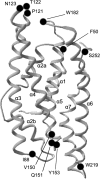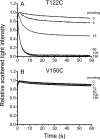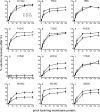Mutations in domain I interhelical loops affect the rate of pore formation by the Bacillus thuringiensis Cry1Aa toxin in insect midgut brush border membrane vesicles
- PMID: 19376918
- PMCID: PMC2698377
- DOI: 10.1128/AEM.02924-08
Mutations in domain I interhelical loops affect the rate of pore formation by the Bacillus thuringiensis Cry1Aa toxin in insect midgut brush border membrane vesicles
Abstract
Pore formation in the apical membrane of the midgut epithelial cells of susceptible insects constitutes a key step in the mode of action of Bacillus thuringiensis insecticidal toxins. In order to study the mechanism of toxin insertion into the membrane, at least one residue in each of the pore-forming-domain (domain I) interhelical loops of Cry1Aa was replaced individually by cysteine, an amino acid which is normally absent from the activated Cry1Aa toxin, using site-directed mutagenesis. The toxicity of most mutants to Manduca sexta neonate larvae was comparable to that of Cry1Aa. The ability of each of the activated mutant toxins to permeabilize M. sexta midgut brush border membrane vesicles was examined with an osmotic swelling assay. Following a 1-h preincubation, all mutants except the V150C mutant were able to form pores at pH 7.5, although the W182C mutant had a weaker activity than the other toxins. Increasing the pH to 10.5, a procedure which introduces a negative charge on the thiol group of the cysteine residues, caused a significant reduction in the pore-forming abilities of most mutants without affecting those of Cry1Aa or the I88C, T122C, Y153C, or S252C mutant. The rate of pore formation was significantly lower for the F50C, Q151C, Y153C, W182C, and S252C mutants than for Cry1Aa at pH 7.5. At the higher pH, all mutants formed pores significantly more slowly than Cry1Aa, except the I88C mutant, which formed pores significantly faster, and the T122C mutant. These results indicate that domain I interhelical loop residues play an important role in the conformational changes leading to toxin insertion and pore formation.
Figures





Similar articles
-
Cysteine scanning mutagenesis of alpha4, a putative pore-lining helix of the Bacillus thuringiensis insecticidal toxin Cry1Aa.Appl Environ Microbiol. 2008 May;74(9):2565-72. doi: 10.1128/AEM.00094-08. Epub 2008 Mar 7. Appl Environ Microbiol. 2008. PMID: 18326669 Free PMC article.
-
Helix alpha 4 of the Bacillus thuringiensis Cry1Aa toxin plays a critical role in the postbinding steps of pore formation.Appl Environ Microbiol. 2009 Jan;75(2):359-65. doi: 10.1128/AEM.01930-08. Epub 2008 Nov 14. Appl Environ Microbiol. 2009. PMID: 19011060 Free PMC article.
-
Chemical modification of Bacillus thuringiensis Cry1Aa toxin single-cysteine mutants reveals the importance of domain I structural elements in the mechanism of pore formation.Biochim Biophys Acta. 2009 Feb;1788(2):575-80. doi: 10.1016/j.bbamem.2008.11.001. Epub 2008 Nov 12. Biochim Biophys Acta. 2009. PMID: 19046941
-
The pre-pore from Bacillus thuringiensis Cry1Ab toxin is necessary to induce insect death in Manduca sexta.Peptides. 2008 Feb;29(2):318-23. doi: 10.1016/j.peptides.2007.09.026. Epub 2007 Dec 14. Peptides. 2008. PMID: 18226424 Free PMC article. Review.
-
Structural insights into Bacillus thuringiensis Cry, Cyt and parasporin toxins.Toxins (Basel). 2014 Sep 16;6(9):2732-70. doi: 10.3390/toxins6092732. Toxins (Basel). 2014. PMID: 25229189 Free PMC article. Review.
Cited by
-
N-Terminal α-Helices in Domain I of Bacillus thuringiensis Vip3Aa Play Crucial Roles in Disruption of Liposomal Membrane.Toxins (Basel). 2024 Feb 6;16(2):88. doi: 10.3390/toxins16020088. Toxins (Basel). 2024. PMID: 38393166 Free PMC article.
-
A Cry1Ac toxin variant generated by directed evolution has enhanced toxicity against Lepidopteran insects.Curr Microbiol. 2011 Feb;62(2):358-65. doi: 10.1007/s00284-010-9714-2. Epub 2010 Jul 29. Curr Microbiol. 2011. PMID: 20669019
-
Effects of mutations within surface-exposed loops in the pore-forming domain of the Cry9Ca insecticidal toxin of Bacillus thuringiensis.J Membr Biol. 2010 Dec;238(1-3):21-31. doi: 10.1007/s00232-010-9315-9. Epub 2010 Nov 17. J Membr Biol. 2010. PMID: 21082167
References
-
- Alzate, O., T. You, M. Claybon, C. Osorio, A. Curtiss, and D. H. Dean. 2006. Effects of disulfide bridges in domain I of Bacillus thuringiensis Cry1Aa δ-endotoxin on ion-channel formation in biological membranes. Biochemistry 45:13597-13605. - PubMed
-
- Angsuthanasombat, C., N. Crickmore, and D. J. Ellar. 1993. Effects on toxicity of eliminating a cleavage site in a predicted interhelical loop in Bacillus thuringiensis CryIVB δ-endotoxin. FEMS Microbiol. Lett. 111:255-262. - PubMed
-
- Aronson, A. I., and Y. Shai. 2001. Why Bacillus thuringiensis insecticidal toxins are so effective: unique features of their mode of action. FEMS Microbiol. Lett. 195:1-8. - PubMed
Publication types
MeSH terms
Substances
LinkOut - more resources
Full Text Sources

